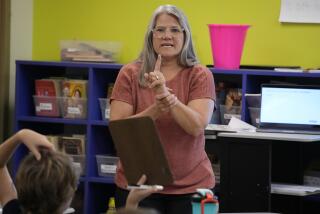He Brings a Little Culture to Math
- Share via
TROY, N.Y — TROY, N.Y. -- Ron Eglash looks at the careful weaves in cornrow hair and sees mathematical patterns. He sees evidence of Cartesian geometry in Indian beadwork and hears a way to teach kids about ratios in syncopated Latin beats.
He is a sort of mathematical detective -- he finds evidence of mathematical design in places as diverse as African villages and American cities. He then helps translate mathematical concepts embedded in the likes of hairstyles and jewelry patterns into educational software. The result is lessons like “Black Hairstyle Mathematics,” crafted with an eye toward attracting students of color to math, with a sweetener of cultural pride.
“There’s already mathematics there -- in the graffiti, in cornrows, in the beadwork,” Eglash said. “And the problem is that the mathematics isn’t in a form that is the same as school math.”
Eglash is an assistant professor at the Department of Science and Technology Studies at Rensselaer Polytechnic Institute, a school by the Hudson River known for turning out engineers. Eglash, 44, a self-professed technophile, seems to fit right in. On a recent day, he showed off his software projects in an office loaded with books on such subjects as cybernetics and chaos theory.
Technology is just one of Eglash’s interests. He also has had a long preoccupation with social causes, including feminism and workers’ rights. He has looked to bridge these two interests -- technology and activism -- since he was a student in the ‘70s.
Unfortunately, he often found the bridge closed.
While earning his undergraduate degree in cybernetics at UCLA, he earned cross looks with classroom questions like, “What about the political side to this?”
A decade later, while working toward his doctorate in the history of consciousness, a suggestion to apply mathematical analyses to the curriculum were sometimes shot down with: “Well, mathematics is a tool of capitalistic imperialism.”
Eglash found a bridge, improbably, while studying Tanzanian villages. Aerial photographs showed circular buildings within circular settings and rectangular buildings within rectangular settings. The patterns repeated themselves large and small -- fitting the definition of fractals.
Starting in 1993, he traveled across Africa on a Fulbright scholarship to investigate evidence of fractals in windscreens, carvings and textiles. He explored villages -- once leaning precariously out of a small airplane to take pictures of layout patterns. His resulting book, “African Fractals,” argues for a mathematical intelligence in African design more complex than generally appreciated.
Eglash’s research fits in squarely with “ethnomathematics,” a term coined in the ‘80s and usually used to describe the mathematical practices of smaller or indigenous cultural groups. While ethnomathematicians have studied Mayan calendars and even boomerang flights, a unifying theme is an emphasis on mathematical accomplishments outside the Western canon.
Advocates see ethnomathematics as a way to make math more expansive and relevant to students from different backgrounds. Critics characterize it as a diversion from numbers that could lead to softer standards.
Eglash said it’s a mistake to think of ethnomathematics as somehow opposed to so-called standard math -- to him, all math is ethnomathematics in the sense that it is always from some particular group. Still, he has criticized lessons that claim to be multicultural mathematics, but are nothing more than standard exercises with “a third-world gloss.”
Of one “rainforest math” computer program, he says: “They had Tatuk and Esteban in the jungle counting coconuts ... it’s just Dick and Jane counting marbles.”
Eglash’s work, in contrast, starts with a cultural artifact and invites the user to explore its mathematical implications. For example, eighth-graders at Chicago’s Foster Park Elementary School who used the “Black Hairstyle Mathematics” program last year manipulated cornrow fractal patterns on a Cartesian grid (where the X and Y axes are plotted on a graph).
“It was something that immediately caught their attention because they could relate to it,” teacher Sylvia Turner said.
Although the subject matter was the “grabber” for the all-black class, Turner said the value of the program was making children more familiar with geometry and manipulating objects on a coordinate grid.
Typical of Eglash’s programs, it was designed in collaboration with his institute students, faculty and the children who will use it.
“Virtual Bead Loom” was developed with the help of students at the Shoshone-Bannock reservation in Idaho. He found that American Indian beadwork based on fourfold symmetry follows the logic of a Cartesian grid.
The Rhythm Wheels software is based on the mathematical syncopation of Latin beats, which can be used to teach ratios and other math concepts, he said. And he just got back from a small Yupik village in Alaska, where he helped develop software based on indigenous star-based navigation.
For now, Eglash posts his creations on the Web, although he is considering selling versions of the software and sharing profits with the communities that helped in design.
“I don’t feel that I actually own the intellectual property to this stuff,” he said. “It’s been a collaboration all the way.”
More to Read
Sign up for Essential California
The most important California stories and recommendations in your inbox every morning.
You may occasionally receive promotional content from the Los Angeles Times.













